

|
All Photographs © Sam Oppenheim
|
|||||||||||||
| ||||||||||||||
| |||||||||||||||||
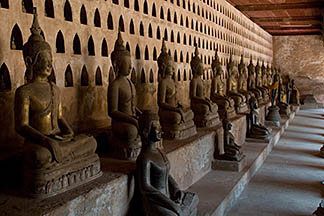
By Sam Oppenheim 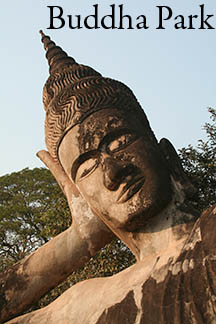
I: VIENTIENNE On March 3rd I arrived in Vientienne, the capital of "The People's Democratic Republic of Lao". Spelled Laos on western maps, and thanks to a French silent "S" pronounced incorrectly as "Lah-Ohs", when it should just be "Lah-Oh". Also did you ever notice that it is communists authoritarian regimes that add 'people's" and "democratic republic' to their names when they are not? 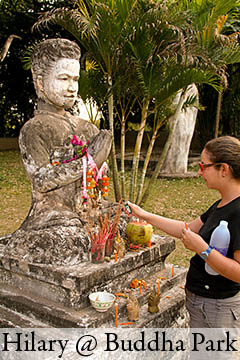
Vientienne is the most chilled-out capital city of any country I have ever visited. No traffic to speak of, quiet streets, low impact small tourist population. A "downtown" completely walkable. Yet neither beautiful nor ugly. I didn't do anything noteworthy, all the Buddhist temples start to blur together in memory, but I do fondly recall a side trip to the "Buddha Park". 45 minutes south by tuk-tuk is a park where some guy built 100 or so concrete sculptures and structures of Buddhist and Hindu Gods, including crocodiles, elephants, naga-snake-gods, a multifaced Brahmin with Buddha-fairies dancing on his eight upturned palms, and a 60-meter long, 10-meter high reclining Buddha! Semi-tastefully done with lots to explore and wander through. The drive there and back gave Mike, Hilary, and myself the first view of Lao's 'countryside'. Just outside of town are rice paddies and views of the Mekong River separating capitalist, wealthy, built-up riverbanks of Thailand from poor, relaxed Laotian communism. Mike & Hilary first pointed out the lack of McDonald's and Starbucks, otherwise ubiquitous in Asia. No 7-11s here, just mom & pop shops, some serving deliciously thick and flavorful Lao coffee (grown in the South). We flew on a Lao Airlines propeller plane to Luang Prabang after 24 hours in Vientienne. Most tourists took the 12 hour bus on curvy-slow roads, or stop half-way in VangVieng where hippies hang out smoking dope, drinking beer, and going downriver on old tires-tubing- in a famous stretch of river filled with enterprising local stalls that hook you in with a bamboo pole and serve you beer if you tire of floating downriver. But we had limited time & wanted to see local tribals & Buddhist culture, not just chill out with foreigners in hostels and party. 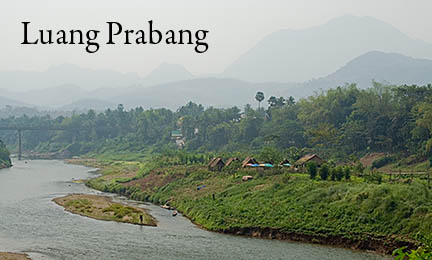 II: LUANG PRABANG
II: LUANG PRABANG
Luang Prabang was perfect! Don't believe everything you read in the New York Times ! We stayed 3 nights, 2 days, and happily would have remained longer. Luang Prabang is an ancient regional capital (and almost became the capital of Laos when the French left Indochina) situated on a peninsula of high land between the merging slow brown Mekong River and cool green-blue Khan River. The landscape is crowned with a central hill topped with a temple and dotted with 5-10 other monasteries (large & small). It is a UNESCO world-heritage city - preserved and controlled development. I do not think there are any three-story buildings in the whole peninsula. The store names are all written in a gold paint on carved wood signs hanging from eaves - no neon, and lots of charming lanterns and lamps. There are bamboo bridges across the smaller river to two nearby villages, and during the day if you linger you can see kids playing, swimming, adult women washing clothes and babies in the river, and men fishing, usually with weighted circular nets thrown like a giant frisbee into the shallows. |
|||||||

|
|||||||
Each monastery has painted walls, Buddhas, and friendly monks. 10-20% of them speak English well enough for light conversation. Most are young students, none told me they would remain monastic. Monastic education is the cultural norm, children go for a free education, get housed and fed, difficult to do in a poor country. So they learn a lot, including respect for Buddhism and other cultural values while also encountering an inordinate number of foreigners and learning to surf the 'net and email before going home, sans robes, to get a job and a wife. |
|||||||

|
|||||||
It is now a tourist-focused town, but it has a unique local flavor that is not tarnished by tourism - yet. It has amazing culinary options unlike most of Laos, a fabulous Hmong night market where we bought a zillion gifts. There are temples galore, orange-robed monks across the landscape, kind-hearted locals, arts & crafts, silk dyeing & weaving classes (Hilary did that), cruises to caves, waterfalls, and swimming holes, and quiet neighborhoods where you don't see tourists if you wander away from the main drag. There are $6/night hostels and $100/night 4-star hotels, both with courtyards, none more than two stories, and only 2 ATMs in town. There are even local volunteer organizations I'd come back to work at. One makes, distributes, and reads aloud children's books (Big brother mouse) and another teaches computers & photography to local teenagers. I enjoyed the latter's gallery "Laos through our eyes" and made a donation. I can't recommend it enough. If you go to one city in one country in all of Southeast Asia, make it Luang Prabang! |
|||||||
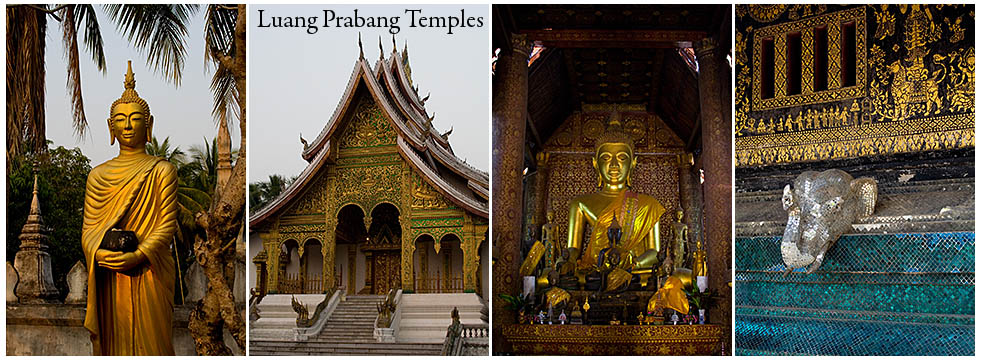
|
|||||||
Our first night I met Mike & Hilary for dinner, but we "accidentally" spent 2 hours shopping the aforementioned amazing street market with all sorts of handicrafts - emerging at the other end empty-pocketed, fully shopped-out, and starving! 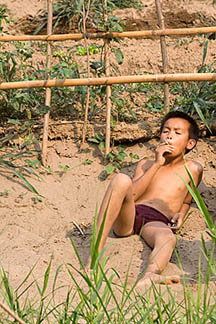
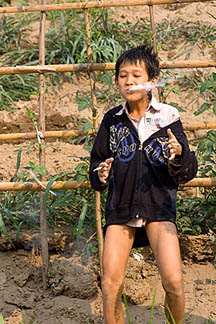
Day two I woke at sunrise and quietly explored the city and riverside crossing the Northern bridge encountering a monk smoking a cigarette. I wanted to photograph him for the incongruity, asked, he said yes, but put his hands-and cigarette- behind him. Later I found a woman hand-making paper with leaves and flowers in it & I bought a lantern, another silly purchase I will have to cart all over Asia! I then found a silk-weaving workshop where the women were feeding mulberry leaves to the young silkworms. I learned that the pupae are boiled alive because otherwise when they break out of their silk cocoon they break the long, strong, single silk fiber into useless small pieces. The fabrics here are exquisite and expensive! Even priced for tourists at $50 per kilogram, its still affordable. Hungry, I took a water taxi back down river and had a sumptuous $5 breakfast with coffee, scrambled eggs, cheese, bread, butter, and fresh fruit. The riverside cafe had a breeze and nice views of the river as well as locals walking about the town. Later while Hilary learned to weave silk, Mike and I wandered the river beach photographing 10-12 year old boys playing in their underwear smoking cigarettes (not inhaling) and laughing uproariously. One little child went into the river, naked, and after peeing was plucked up by one arm, dangling, her mother lifted her from the river up to the bamboo bridge, while an incongruous airplane flew overhead above the golden spire of a distant temple in the forested hills surrounding Luang Prabang. III: NORTHERN LAOS TREK 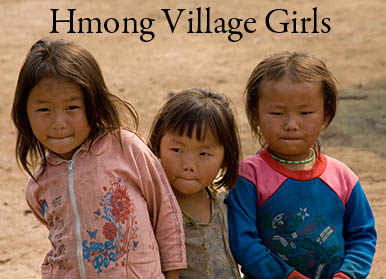
March 7th was spent on a bumpy uncomfortable old bus for 9 hours to Lunag Nam Tha in the North, nearer to the Chinese border. For the first 5 minutes we laughed at the karaoke videotape playing loudly in the front of the bus. Hilarious low-budget un-coordinated Tai or Lao girls dressed like prostitutes with too much makeup danced while the male lead sang. Think of Robert Palmer's 1980's "Addicted to Love" video. But t quickly got irritating - eventually the Western passengers conspired to unplug the TV when we stopped, and asked to keep it off, please! Hours later, they put it back on again to our chagrin. Although the scenery was spectacular, the bus was both slow and dizzying. Recently I read a tour guide that describes Chinese, Vietnamese, Cambodian, and Indian busses better than I can: - Rob Sangster from Traveler's Tool Kit |
|||||||

|
|||||||
For March 8th & 9th Hilary, Lev, Ela, and I hiked, sleeping at a hill tribe village (Mike stayed behind to relax and work on www.spothopping.com). On a side note, it was strange for us that there were no eggs for sale in Northern Laos, nor chickens served as food. We found out there is a ban, with heavy fines, to prevent the spread of bird flu. Aha! That's why there was a police checkpost we passed through in a mountain town north of Luang Prabang. 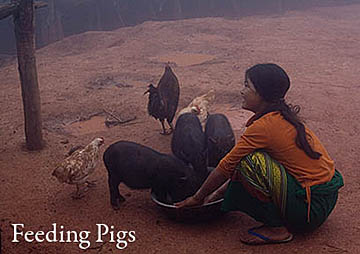 We passed through 5 villages of 3 different ethnicities on our trek: Hmong, Akha, and Thai-Nue. Each was quaint, with different foods, livestock preferences, and architecture. But most people wore western clothes except for the older women. Hmong houses are wood and thatched-roof, but sat on the ground. A few were elevated off the ground 6 inches on upturned-half-buried beer bottles - this to deter termites! The Akha build 'floating houses' I'd seen in India's Northeast & Thailand- Stilts hold a house up above an open 'garage' underneath for storage, working in the shade, and keeping livestock. The Akha also have an interesting and complex spirit-world ideology: they are not Buddhists. Each town has spirit gates to ward off evil, and other sacred bamboo totems in town we were instructed not to touch. They also have a 'third gender' like some Native American tribes - spirit talkers who dress and act funny and live outside the normal social fabric. They are paid in barter or cash, do not marry, and provide services to villages. My favorite Akha cultural tidbit however, was their "love nests": small stilt-raised structures large enough for a king sized bed, and that's all. They are built for drying rice after harvest and are also boy's clubhouses where teenagers sleep when they don't want to be at home, but before marriage. The boys try to convince unmarried girls to sleep with them there, and eventually they "get hitched" by choice or pregnancy to a chosen or accidental girlfriend. Akha and others in Laos drink a rice whisky called Lao-Lao that aids in festivity and debauchery. 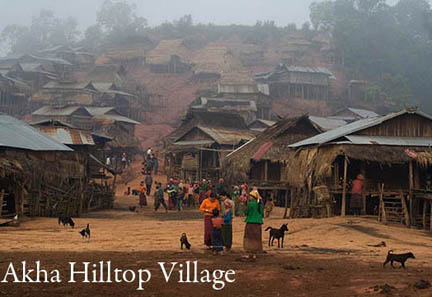
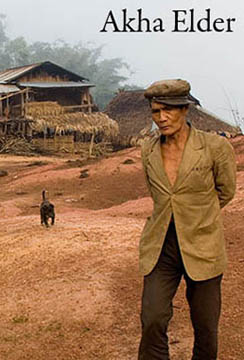 After a long, arduous uphill hike in the rain, the weather cleared as we topped a ride overlooking 3 valleys and we hiked past clearings that were once villages (they practice swidden- or slash & burn agriculture, and therefore abandon less productive villages after a generation to let the forest reclaim the hills). After a nice more flat section of trekking,
we eventually arrived at our homestay Akha village, were served dinner, drank Lao-Lao, received an awful free 'welcome massage' by girls who had no idea where muscles or bone are, and what 'pacing' means.
After a long, arduous uphill hike in the rain, the weather cleared as we topped a ride overlooking 3 valleys and we hiked past clearings that were once villages (they practice swidden- or slash & burn agriculture, and therefore abandon less productive villages after a generation to let the forest reclaim the hills). After a nice more flat section of trekking,
we eventually arrived at our homestay Akha village, were served dinner, drank Lao-Lao, received an awful free 'welcome massage' by girls who had no idea where muscles or bone are, and what 'pacing' means.
The village was welcoming, friendly, and very nice to spend a day in. As Ela put it, however, we would have an even better experience if we stayed longer, helped them farm, cook, weave, hunt, & slaughter. I'd get better photos also as I'd be more than a pass-thru tourist, and they would enjoy our company more as well! Entering this hilltop village in the evening post-rain was like viewing a Martian landscape. Stilted floating homes hover above eroded crenulated red-clay soil. It was also full of barking dogs, clucking chickens, squealing piglets, and playing children. The youths came to us, genuinely interested in seeing the foreigners and only half were averse to being photographed. Boys rolled tires with sticks, racing on imaginary courses. Girls giggled, chasing boys and slapping each other playfully. Boys also played games of skill with slingshots. Older teenagers wove sashes or spun threads while gossiping, while older men and women carried babies on their backs, talking and canvassing the community. |
|||||||
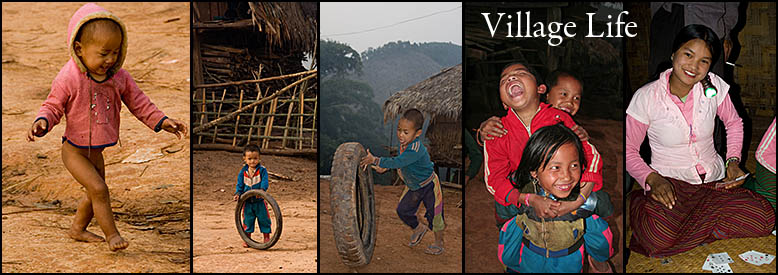
|
|||||||
The Akha people's aged, weathered countenance is testament to the hard life they lead. Although seemingly happy, they straddle tradition and modernity, and their traditional way of life is partially re-invented. This region was recently a community of opium addicts and opium farmers all-but-enslaved to Britain, France, and China. The women did all the work while the men smoked dope and according to what I heard it was an awful dark time for all the communities. In the past 40 years, however, they have learned to farm rice, sugar cane, and rubber trees. Oddly, they buy the seeds from china, and sell the raw produce back to China. Then, if they want processed sugar or rubber toys, they buy finished products from their raw materials, back from China! They are a poor dependency, like a colony, of China to the north. Yet they have economic gains and some modern comforts: no toilets, but a single petroleum generator, one TV, and one satellite or community viewing of football (soccer), wrestling, boxing, and whatever else they prefer on special occasions. |
|||||||
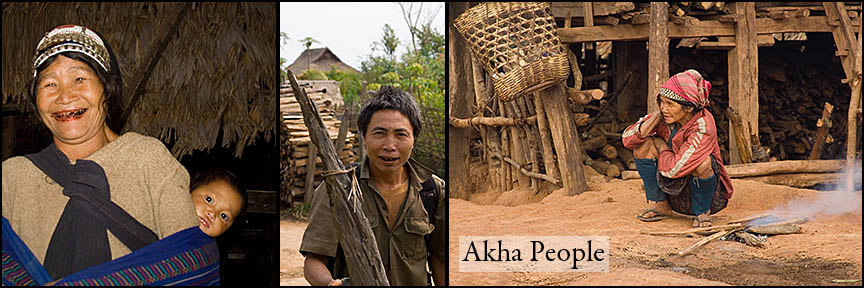
|
|||||||
The strangest thing is their aversion to toilets: supposedly a German NGO taught them how to dig pits and use ash to cover them, but they refused to use them, saying "A father and daughter cannot use the same toilet". Yet what they do do is gross to our sensibilities: they prefer to go to the village outskirts and squat in semi-privacy while dogs and pigs wait nearby, eager to eat the human leavings, ich! Our guide told us to take stones with us, because sometimes the animals try to come and lick you clean so if you want privacy and cleanliness you have to shout and pelt them to deter them. The hike down was easy enough, at the valley bottom we passed through our third Akha village. There the locals were hand-hewing large wood logs with adzes and axes to build a traditional house. Women nearby were weaving grass roofing. Before heading back to town we walked another 5 kilometers and through a Thai-Nue village. As this village was 'the end of the road' it had more modern housing, more bricks and cement. They are also Buddhist and had a temple, as well as colorful domesticated turkeys. |
|||||||
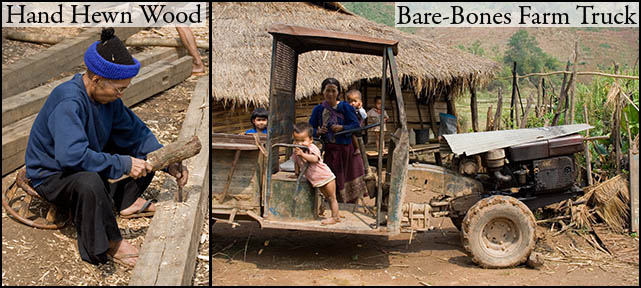
|
|||||||
|
That afternoon we picked up Mike and returned to Luang Nam Tha where we said goodbye to the Israelis and met Loulou & Christine - two English women who agreed to share their private hire mini-van with us the next day. 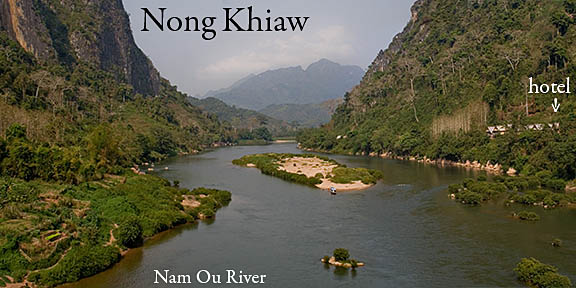 IV: NONG KHIAW
IV: NONG KHIAW
On March 10th we drove South and East to another idyllic nook of Laotian paradise: Nong Khiaw. This fishing village is nestled along the Nam Ou River under the sheer cliff face of enormous "Sleeping Princess Mountain". 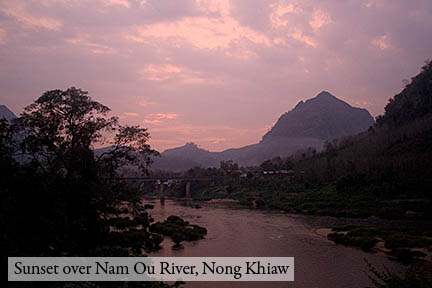
We stayed two nights at a "splurge-worthy" hotel for $30/night. I had a large cabin with a canopy bed, hardwood desk, attached bathroom, and spacious balcony overlooking the river, cliffs, and unforgettable sunsets. There's nothing much to DO there, but that's kinda the point! Mike & I did hire a local to teach us to fish with the "zero net" which we eventually got good enough at to throw correctly, even if we caught no fish (but lots of riverweed and one crustacean). I swam in the river, read, ate good food, and most importantly: relaxed. |
|||||||
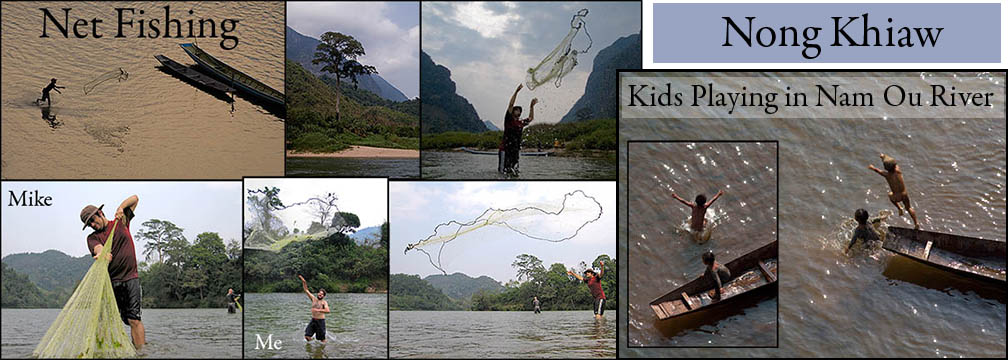
|
|||||||
|
We decided to return to Luang Prabang on a river cruise, but the scheduled departure was 11am and I decided to hire a private boat, if I could find enough passengers to split it so we could cruise in the morning and arrive in LP sooner. Asking all the foreigners I saw, I got 4 more on board, so the Englishwomen, Mike, Hilary, and myself filled the boat which left the next morning. We descended along the smooth waters through fantastic peaks clothed in clouds and fog like Chinese wood-cuts. It was a very dramatic and beautiful landscape, like a fairytale. We stopped once on a river beach with sun-heated sand and a herd of light-grey water buffaloes for a quaint unique toilet break. Then we continued downstream in the now gorgeous sunshine and blue skies of a fully blossomed day. |
|||||||

|
|||||||
|
In Luang Prabang we booked a flight for the next day to Siem Riep in Cambodia. I dined at a riverside cafe and ate "Mekong river fish in coconut milk soup" while Mike & Hilary tried fine dining with steak and red wine at "L'Elephant". Then we 3 splurged at the most extravagant parlor in town: "Spa Garden" where massages were $6 instead of the usual $5, and I had a $3 Lao-herbal-sauna, filled with minty-herbal-steam. Maybe next time I'll have the 3-hour $40 princess treatment including a foot, body, and face massage, then sauna, manicure, and facial! I highly recommend Laos, more than any other new country I've been to this year - it's the only one I really, really want to return to! |
|||||||
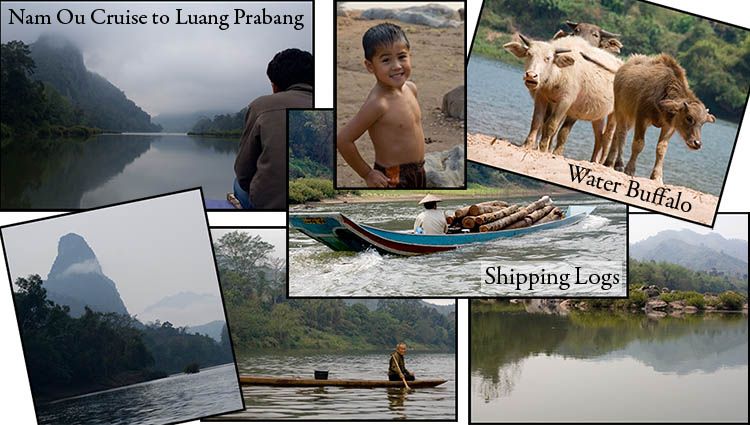
|
|||||||
|
|